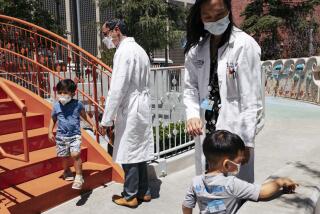Helping Kids Breathe Easier : Health: Asthma rates among children have skyrocketed. Although the causes of the upsurge are unclear, experts say there are ways to minimize the disease’s effects.
- Share via
It began with a cough, usually at night.
For four years, little Jonathan Castillo coughed and sneezed. His parents were told that he was prone to colds, pneumonia and allergies. Doctors prescribed antibiotics and lots of cough syrup.
Finally, when Jonathan was 6, a doctor put a name on the boy’s condition: asthma.
But having a diagnosis didn’t mean that Jonathan was going to get the right treatment.
For another two years, the family battled repeated, life-threatening asthma attacks, when the passageways in Jonathan’s lungs would narrow so tightly that he could scarcely breathe. They visited the emergency room almost weekly. Jonathan missed a total of one to two months of school in Valencia each year. He fell behind. He felt bad. His parents were frustrated.
And they were not alone.
According to several new studies, asthma rates among children have skyrocketed during the last two decades--a baffling trend that experts say is accompanied by widespread ignorance and mismanagement of the condition.
For reasons that are unclear, rates among children and adolescents have doubled (and even tripled in some age groups) over 20 years, according to a recent analysis by the Mayo Clinic in Rochester, Minn.
Government officials report that more than 2.7 million children under age 18 have the disease. Asthma is the leading cause of hospitalization among children and the leading cause of school absenteeism.
Experts say the increase probably is caused by several factors, including greater outdoor air pollution, more airtight buildings that trap indoor pollutants, a rise in smoking among mothers and new kinds of viral infections.
But the worst part of the surge, health officials agree, is that children are often misdiagnosed or under-treated, while their families do not receive proper instruction on keeping the disorder under control.
“Even though we can’t say what is causing the asthma increase, there are a lot of things we can do to prevent hospitalization and deaths,” says Dr. Peter Gergen, of the Washington-based National Institute of Allergy and Infectious Disease. “We know enough now to make a difference.”
During an attack, the passageways to the lungs, bronchi and bronchioles constrict as tissues lining them swell and mucus accumulates. Symptoms include wheezing, coughing, sneezing, frequent colds, sinus trouble, rashes and itching. Attacks can be triggered by allergies, viral infections, exercise, or sensitivity to medications or chemicals.
In 1991, federal officials recommended redefining asthma as a chronic inflammatory condition, although traditionally it has been thought of as producing periodic lung spasms requiring emergency treatment. Now, health officials are promoting preventive care to limit severe attacks.
“A lot of recent work has been directed at the idea that asthma is not a short-term problem,” Gergen says. “Children tend to outgrow asthma as they go through adolescence, but it tends to be a chronic problem until they outgrow it. Like all chronic diseases, asthma requires commitment and understanding of the therapy for good control--by both the health-care provider and the patient.”
But patient education and a detailed prevention strategy is something that a lot of children and their families aren’t getting.
“Asthma can be treated very successfully. But so often, families are led to believe that they have to settle for far less,” says Sharron Reynolds, a nurse and program director for the Los Angeles chapter of the Asthma & Allergy Foundation of America.
Children’s asthma rates are particularly high in the inner cities, experts say, possibly because youngsters there may not have access to long-term care and education.
Two years ago, federal officials began a seven-city study to determine the causes of asthma in inner-city children and how to address the problem. An initial report is expected next year.
“I suspect the issue of access to care and the ability to get and take medicines is the predominant reason” for such high rates, Gergen says.
Overall, the goal in managing asthma is to reduce the number of attacks by using preventive medicine, eliminating possible allergens and monitoring breathing capacity.
Two years ago, Nora Castillo decided to learn everything she could about asthma in hopes of helping Jonathan improve. What she found out astounded her.
“We were not doing anything preventively. We didn’t even know preventive care existed,” she recalls. “From the time he was 2 until about 8, all we were doing was treating the symptoms and putting out fires. It was exhausting and frustrating.”
Eventually, the family took a a class, called Asthma Care Training, offered to families nationwide. Castillo called the asthma foundation for advice, and with nurse Reynolds’s help and their physician’s cooperation, the family came up with a management plan.
They bought an inhaler to administer medication and a peak-flow meter to measure the openness of Jonathan’s lungs. In addition, Jonathan began taking oral anti-inflammatory medication, and the family combed their house to reduce dust-gathering possessions that could trigger attacks. Out went the shag carpeting, curtains and quilts. Mattresses and pillows were encased in plastic.
Jonathan’s emergency room trips have been reduced from about 45 a year to seven last year, his mother says.
“What we did made such a big difference,” she says. “Jonathan (at age 10) feels better now, and he’s concentrating and doing better in school.”
In Studio City, Justin Andrews also benefited from an aggressive preventive approach to controlling the disease, says his mother, Carol. After several hospitalizations, Justin began using medication to prevent attacks, as well as a peak-flow meter. Now 9, he is rarely ill.
“He comes in from baseball practice and he’s breathing hard, but his airways are open. Very seldom do I hear him wheezing,” says Andrews. “It’s just a big turnaround.”
When the condition is properly managed, children should have normal or near-normal breathing, normal levels of activity and exercise, no symptoms, fewer attacks and no side effects from medication, says Dr. Richard Harris, a pediatric allergist in Beverly Hills.
“I like to see kids be able to go out and play soccer or do whatever they want to do,” Harris says. “If you treat it aggressively, kids can have a normal life.”
Besides the Asthma Care Training family program, other help is available, says Francene Lifson, executive director of AAFA’s Los Angeles chapter. The agency also offers parents groups and a range of resources and support services, including a telephone hot line.
In addition, an allergy foundation grant has been used to establish a free clinic at UCLA for children with asthma. The program will provide free medication and medical care to uninsured children with the disease.
“We have found that so many people don’t know we exist,” says Lifson. “It’s pretty scary when a child can’t breathe. We need to help the parents, as well as the child who is suffering.”
Asthma Warning Signs
* Frequent colds, viral infections or episodes of bronchitis
* Chronic cough or a cough with colds or exercise (especially common at night)
* Rash and / or itching
* Wheezing / difficulty breathing
* Chest sucked in around ribs, collarbone and throat
* Sinus trouble
* Severe reaction to insect stings
* Itching eyes, nose or throat
For more information on asthma and how to manage it:
* Asthma & Allergy Foundation of America, Los Angeles Chapter: (800) 624-0044.
* American Academy of Allergy & Immunology Physicians’ Referral and Information Line: (800) 822-2762.
* American Lung Assn.: (213) 935-LUNG or (818) 797-LUNG.
Source: Asthma & Allergy Foundation of America, Los Angeles Chapter






